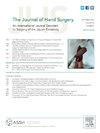Radial Collateral Ligament Laxity of Thumb Metacarpophalangeal Joint Following Trapeziometacarpal Arthrodesis
IF 2.1
2区 医学
Q2 ORTHOPEDICS
引用次数: 0
Abstract
Purpose
Trapeziometacarpal (TM) arthrodesis may increase adduction motion of the thumb metacarpophalangeal (MCP) joint, causing radial collateral ligament laxity. Stability of the MCP joint is important to the long-term functional outcome after TM arthrodesis. This study assessed preoperative and postoperative radial collateral ligament laxity using dynamic radiographs to confirm whether laxity was exacerbated after surgery and examined whether there is a relationship between the fixation angle of arthrodesis and the degree of laxity.
Methods
Forty-four thumbs in 33 patients who underwent TM arthrodesis and were followed for at least 5 years were studied. Dynamic radiographs in radial adduction-abduction and palmar adduction-abduction were obtained. We defined the midpoint of arc of motion as the fixation angle of arthrodesis in the radial and palmar planes. We measured the intersection angle between longitudinal axis of the first metacarpal (M1) and that of thumb proximal phalanx (P1). P1M1 angle in a palmar adduction view of dynamic radiographs reflected radial collateral ligament laxity in palmar adduction (adduction P1M1 angle). We subtracted a preoperative adduction P1M1 angle from a postoperative adduction P1M1 angle and defined its value as an exacerbated adduction P1M1 angle.
Results
Adduction P1M1 angle increased from 9° ± 5° to 18° ± 10°. The median exacerbated adduction P1M1 angle was 7°. Ten thumbs (23%) developed ulnar subluxation of MCP joint in the palmar adduction view of dynamic radiographs. Among them, two thumbs developed osteoarthritis of MCP joint (5%). Fixation angle of the arthrodesis was a mean of 35° ± 7° and 32° ± 9° in the radial arc and palmar arc planes, respectively. There was a positive correlation between increasing adduction P1M1 angle and TM arthrodesis in an increasingly palmarly abducted position.
Conclusions
Radial collateral ligament laxity of thumb MCP joint was exacerbated after TM arthrodesis. Greater fixation angle in palmar abduction resulted in more laxity of the joint.
Type of study/level of evidence
Prognostic IV.
拇指掌指关节的桡侧副韧带松弛(肩胛骨掌指关节切除术后
目的:拇掌指关节(MCP)内收活动增加,导致桡侧副韧带松弛。MCP关节的稳定性对TM关节融合术后的长期功能预后非常重要。本研究使用动态x线片评估术前和术后桡侧副韧带松弛程度,以确认术后松弛程度是否加重,并检查关节融合术固定角度与松弛程度之间是否存在关系。方法对33例TM关节融合术患者44根拇指进行5年以上随访。桡骨内收外展和掌部内收外展的动态x线片。我们将运动弧的中点定义为关节融合术在桡面和掌面的固定角。测量第一掌骨(M1)纵轴与拇指近端指骨(P1)纵轴交角。动态x线片掌内收P1M1角反映掌内收桡侧副韧带松弛(内收P1M1角)。我们将术前内收的P1M1角与术后内收的P1M1角相减,并将其定义为加重内收的P1M1角。结果内收P1M1角由9°±5°增加到18°±10°。中位加重内收P1M1角为7°。在动态x线片掌内收视图中,10个拇指(23%)出现MCP关节尺侧半脱位。其中2根拇指发生MCP关节骨性关节炎(5%)。关节融合术桡骨和掌骨的固定角度分别为35°±7°和32°±9°。掌侧外展位置P1M1内收角增加与TM关节融合术呈正相关。结论TM关节融合术后拇指MCP关节桡侧副韧带松弛加重。掌外展的固定角度越大,导致关节更松弛。研究类型/证据水平
本文章由计算机程序翻译,如有差异,请以英文原文为准。
求助全文
约1分钟内获得全文
求助全文
来源期刊
CiteScore
3.20
自引率
10.50%
发文量
402
审稿时长
12 weeks
期刊介绍:
The Journal of Hand Surgery publishes original, peer-reviewed articles related to the pathophysiology, diagnosis, and treatment of diseases and conditions of the upper extremity; these include both clinical and basic science studies, along with case reports. Special features include Review Articles (including Current Concepts and The Hand Surgery Landscape), Reviews of Books and Media, and Letters to the Editor.

 求助内容:
求助内容: 应助结果提醒方式:
应助结果提醒方式:


